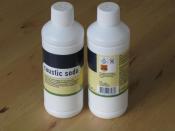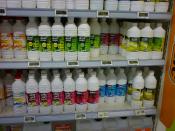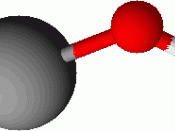Aim: To carry out three experiments where we will calculate the development of heat and the change in enthalpy by measuring the change in temperature in different substances. By doing so, it will give us a better view of why Hess's law is important and how it can be applied.
Material and safety assessment plan: Thermos, thermometer with scale to 0.1 ðC, a stirrer, a spoon, measuring glass (200 cm3), and a regular glass container. The chemicals needed for this lab are: Sodium hydroxide in tablet-form, 0.5 moles of NaOH and HCl, and an additional 0.25 moles of HCl.
During this lab, safety glasses and aprons must be worn at all times to prevent accidents. Avoid contact with skin when handling the chemicals. All the chemicals easily corrode when in contact with skin or clothes and so these need to be handled with care. After the experiments, the solutions will be neutralized and can be rinsed off in the sink.
Method: Three experiments are part of this lab:Experiment A: Reaction: NaOH (s) â NaOH (aq) ÃÂHAWe poured 200 cm3 of water in the thermos and measured the temperature as precise as we could. Then we weighed 2 g of Sodium hydroxide tablets in a glass container and started stirring it with the water. After they were dissolved into the water we measured the temperature. After this, we reached all the data we needed for calculating the ÃÂHA, and so we did.
Experiment B: Reaction: NaOH (aq) + HCl â NaCl (aq) + H2O (l)ÃÂHBWe poured 100 cm3 of 0.5 molar HCl in the thermos and measured the temperature. We then poured 100 cm3 of NaOH and measured the temperature there as well, and then calculated the mean temperature between both of the substances. Then we mixed the two together and measured the temperature. Through this, we managed to calculate the ÃÂHB.
Experiment C:Reaction: NaOH (s) + HCl (aq) â NaCl (aq) + H2O (l) ÃÂHCWe poured 200 cm3 of 0.25 molar HCl in the thermos and measured the temperature. After doing so, we added 2 g of the tablet-NaOH to it, and measured the temperature after dissolving these in the HCl.
Results:Reaction A: NaOH (s) â NaOH (aq) ÃÂHAMass of NaOH (in g)2.26 gAmount of substance NaOH (mole)40 g/mol â 0.0565 mol1Change in temperature: ÃÂt2.7 ðC2Mass of solution (kg): m0.2 kgHeat (kJ) = W (4200 x m x ÃÂt)2268 J = 2.268 W (kJ)3Enthalpy change (kJ/mol NaOH) = ÃÂHA40141.59292 J/mol â 40.1 kJ/mol4Reaction B: NaOH (aq) + HCl â NaCl (aq) + H2O (l)ÃÂHBConcentration NaOH (mol/dm3)0.50 mol/dm3Volume NaOH (aq)100 cm3 = 0.1 dm3Amount of substance NaOH (mol)0.05 molTemperature change = ÃÂt0.975 ð C5Mass of solution (kg) = m280 ml = 0.28 l = 0.28 kgHeat (kJ) = W (4200 x m x ÃÂt)1146.6 J = 1.1466 W (kJ)6Enthalpy change (kJ/mol NaOH) = ÃÂHB22.932 kJ/mol7Reaction C: NaOH (s) + HCl (aq) â NaCl (aq) + H2O (l)ÃÂHCMass of NaOH (in g)2.11 gAmount of substance NaOH (mol)40 g/mol = 0.05272 mol8Temperature change = ÃÂt2.13 ðC9Mass of solution (kg) = m195 ml = 0.195 l = 0.195 kgHeat (kJ) = W (4200 x m x ÃÂt)1744.47 J = 1.74447 W (kJ)10Enthalpy change (kJ/mol NaOH) = ÃÂHC33.070521 kJ/mol11Conclusion and discussion: After all the experiments had been made, the aim of the lab became clearer; there is a connection between the reactions. The first and the second reaction should together make up the third one, although our results do not really support this at all by just looking at the graph (above). Both first reactions should have made about 40 kJ/mol, respectively. Logically, this would mean that the last reaction should be about 80 kJ/mol (40 + 40 = 80 kJ/mol). The three reactions were just different ways of reaching the same result: NaCl (aq) + H2O (l). If everything would have gone the way it should have, we would have proof of that in our results. Experiment A was dissolving solid NaOH into aqueous NaOH, and the following experiment was turning the result of the previous one into salt (NaCl) and water, i.e., neutralizing the solution in an acid-base reaction.
The reason why our final results of enthalpy change were wrong, might be because my collaborator and I accidentally measured the temperature a little wrong, which results in making the final answer quite unreasonable, as it affects all calculations while getting to it.
The reason why reaction C was (supposed to be) the one with the most enthalpy change was because everything that we made happen in two reactions (A and B), we fit into one (C), as A + B = C. In reaction C, the NaOH was first solved into an aqueous solution, and then neutralized into salt and water. As this happens, a whole lot of heat is released (as forming bonds release energy, while breaking them absorbs it); the reaction is exothermic, just like reaction A and B. This is an explanation for why the heat rose during the process of the reaction, and that was what we measured when trying to reach the enthalpy change. So, the relation is the energy released in the reactants = energy in product.
Appendix:1 2.26 g / 40 g/mol = 0,0565 mol2 23.3ðC - 20.6 ðC = 2.7 ðC3 4200 x 0.2 kg x 2.7 ðC = 2268 J4 2.268 kJ/0.0565 mol = 40,14159292 kJ/mol5 (20.18 ðC + 18.03 ðC)/2 = 19.105 ðCÃÂt = 20.08 ðC - 19.105 ðC = 0,9756 4200 x 0.28 kg x 0.975 ðC = 1146,6 J7 1.1466 kJ/0.05 mol = 22,932 kJ/mol8 2.11 g/ 40 g/mol = 0,05275 mol9 22.3 ðC - 20.17 ðC = 2.13 ðC10 4200 x 2.13 ðC x 0.195 kg = 1744,47 J11 1.74447 kJ/ 0.05275 mol = 33,0705 kJ/mol





